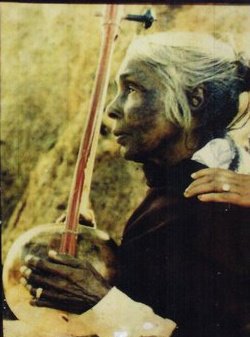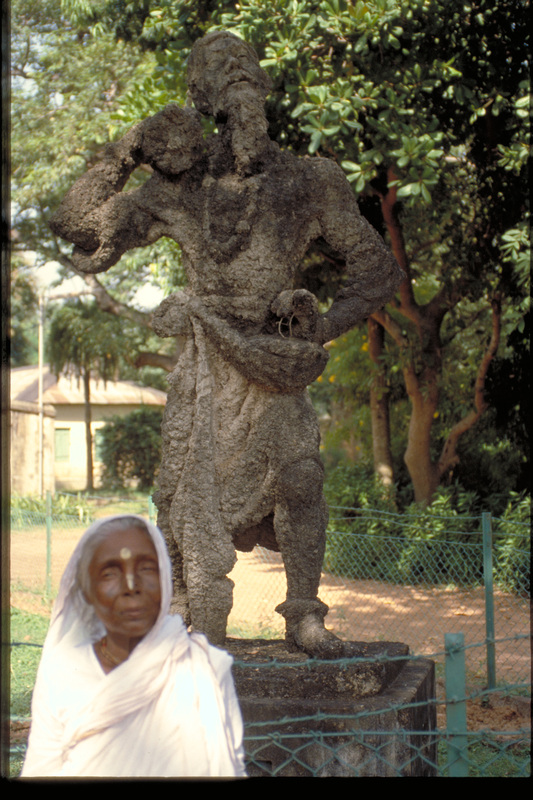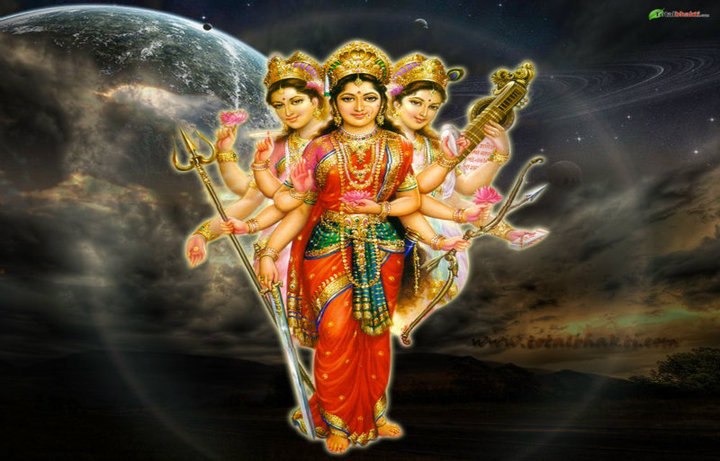
In Tantrism, the three letters of Bhairava are taken to mean: ‘Bha’ means bharana or maintenance; ‘ra’ means ravana or withdrawal and ‘va’ means creation of the universe. Bhairva manifestation is traced in the Shiva Purana. Lord Shiva takes the form of Kala Bhairava to behead Brahma in a superiority contest between Vishnu and Brahma. Thus, Kala Bhairava embodies the wrathful side of the Lord Shiva. He can be invoked for destroying negative energies and for protecting us as well.
These tremendous energies emphasize why it is important to honor Kala Bhairava, the Lord of Time. He is shown carrying Brahma’s decapitated head. Since he killed a Brahmin, Shiva was forced to carry this skull and roam as Bhikshatana until his sins were absolved in Kasi. In the rural settings, Bhairava is a grama devata. In the South and among Tamil speaking bhaktas, He is known as Vairavar or Annadhani. He is the caretaker and punisher. Iconographically, Bhairava is accompanied by his dog, Shvan. His consort is Bhairavi, another fierce and terrifying aspect of Goddess Devi.
Maha Bhairavar is a reference to Lord Shiva himself. The traditional listing of eight manifestations of Bhairavas are: Asithanga Bhairavar, Ruru Bhairavar, Chanda Bhairavar, Krodha Bhairavar, Unmatta Bhairavar, Kapala Bhairavar, Bhishana Bhairavar and Samhara Bhairavar. In Shiva temples, regular puja starts with Surya and ends with Bhariavar. The best time for Bhairava worship is the midnight puja on a Friday.
DEPICTION:
Bhairava deity is usually situated in north or south facing direction. As a deity, Bhairava appears in a standing position with four hands. His weapons are damaru, pasam noose, trine and skull. Sometimes, Bhairava is shown with more hands. He appears semi or fully naked. He is accompanied by his Vahana, a dog. The dog is not just a means of transport but is an seaul participant in Bhairava’s ferocious activities. Bhairava has protruding teeth and looks terrible. His garland is made of red flowers.
ATTRIBUTES
of the Ashra Bhairavas are:
(1) Asitanga Bhairava: golden complexion, with well-formed limbs, and carries the Trishula, Damaru, Pasha noose and Khadga sword
(2) Ruru Bhairava: pure white, adorned with ornaments set with rubies. Ruru carries the akshmala rosary, a Pustaka book, Ankusha, elephant goad and a Vina lute.
(3) Canda Bhairava: Blue color and good-looking. Canda carries Agni, Shakti spear, Gada mace and Kunda water pot
(4) Krodha Bhairava: smoke color carrying Khetaka shield, a long Khadga sword and Parashu (axe).
(5) Umnatta Bhairava: white color, good-looking and carry in their hands the Kunda, iron bludgeon, the Khetaka, club studded with iron, the Parigha iron club and Bhindipala javelin.
(6) Kapala Bhairava: yellow color, carrying the same weapons as Unmatta.
(7) Bhishana Bhairava: red colour.
(8) Samhara Bhairava: Lightning color.
Kapala, Bhishana and Samhara Bhairavas carry the same weapons as Unmatta.
Each of the Bhairava manifestations represent, Akash, air, fire, water and earth and the other three being sun, moon and atma. Each of the Bhairavas are different in appearance, have different weapons, different bahanas. They also represent the Ashta Lakshmis.
It is to be noted that by and large, Bhairava conception of Lord Shiva gave birth to Aghora and Bhairava groups carrying skull-bowls, wearing garlands of skulls or severed heads. They besmear ashes of burnt human bodies and are usually unshaven and appear disorderedly with unfurling locks of hair. Their prayers are cemetery-clad and steeped in mystery.
DIRECTIONS:
Conceptualized as Shani, Guru of the planet Saturn, Bhairava is the moving form of Lord Shiva and they guard the directions. The eight Maha Bhairavars control the eight directions of this universe. This is also the depiction of the rural grama devata, Vairavar who is said to guard the ‘ettu tikku’ or eight directions which he stands to safeguard bhaktas.
Each Bhairavar has eight sub- Bhairavars under them. All of the Bhairavars are ruled and controlled by one Maha Sorna Kala Bhairavar, who is the supreme.
DIRECTIONS IN BUDDHISM:
There is a parallel in Buddhism with Darmapala or Defenders of the law. They are also grouped in eight called the ‘The Eight Terrible Ones’. This has its Vedic origins as Dikpalas or the Guardian of Directions. They are (1) Indra, Lord of East, (2) Agni, Lord of the South-east, (3) Yama, of the South, (4) Nirti, of the South-west, (5) Varuna, of the West, 6) Vayu, of the North-west, (7) Kubera, of the North, 8) Ishana of the North-east.
64 FORMS:
The 64 forms of Kala Bhairava are eight types of Bhairavas from each of the main forms. Their worship beings individual benefits. 1.Asidanga Bhairava: Gives creative ability; 2. Guru Bhairava: Divine educator; 3. Chanda Bhairava: Gives incredible energy, cuts competition and rivals; 4. Kroda Bhairava: Gives you the power to take massive action; 5. Unmatta Bhairava: Controls negative ego and harmful self talk; 6.Kapala Bhairava: Ends all unrewarding work and action; 7. Bhishana Bhairava: Obliterates evil spirits and negativity and 8. Samhara Bhairava: Complete dissolution of old negative karmas
KSHETRABALAR:
Sometimes Bhairava plays the role of Kheshtrabalar or Kshetrapalakar. Thus his deity is found on both sides of the door to the sanctum of the main deity. Sometimes prayers are made to the kshetrabakar independent of the main deity. This is His guardian role in the Shaktipeeths and Jyotirlinga temples. In Shaktipeeth temples, a separate temple is dedicated to Bhairava. In Jyotirlinga temples, Bhairava’s shrines are present within the sanctum sanctorum are not far away from the Linga.
SWARNA AKARSHANA BHAIRAVA:
Other than these eight forms there is yet another form called Swarna Akarshana Bahiravar. He has red complexion and clothed in golden dress. He has moon in his head. He has four hands. In one of his hands, he carries a golden vessel. He gives wealth and prosperity. This manifestation would be posted separately with more details.
Hara Hara Mahadeva
(draft Bhairava folder. cf Samhara Bhairava folder; Tantrism; Aghoris; Bhairava ashtami)
Yogi Ananda Saraswathi
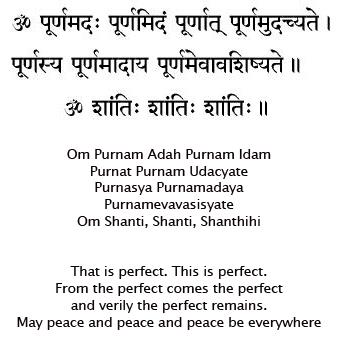

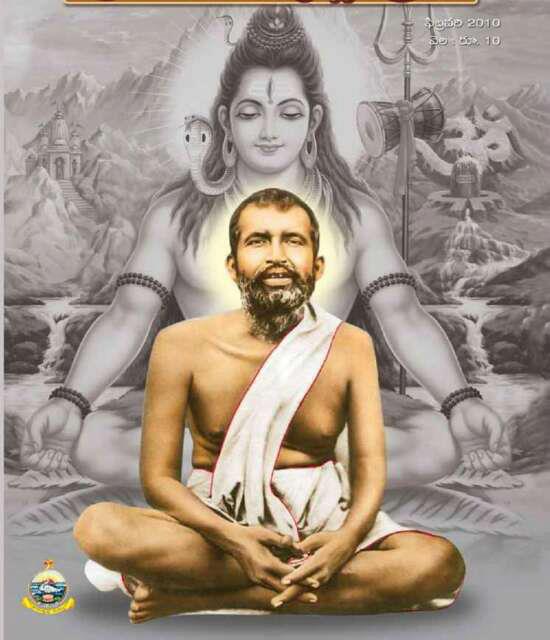

















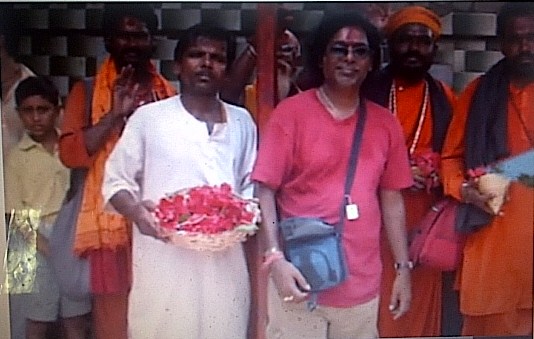




 RSS Feed
RSS Feed
